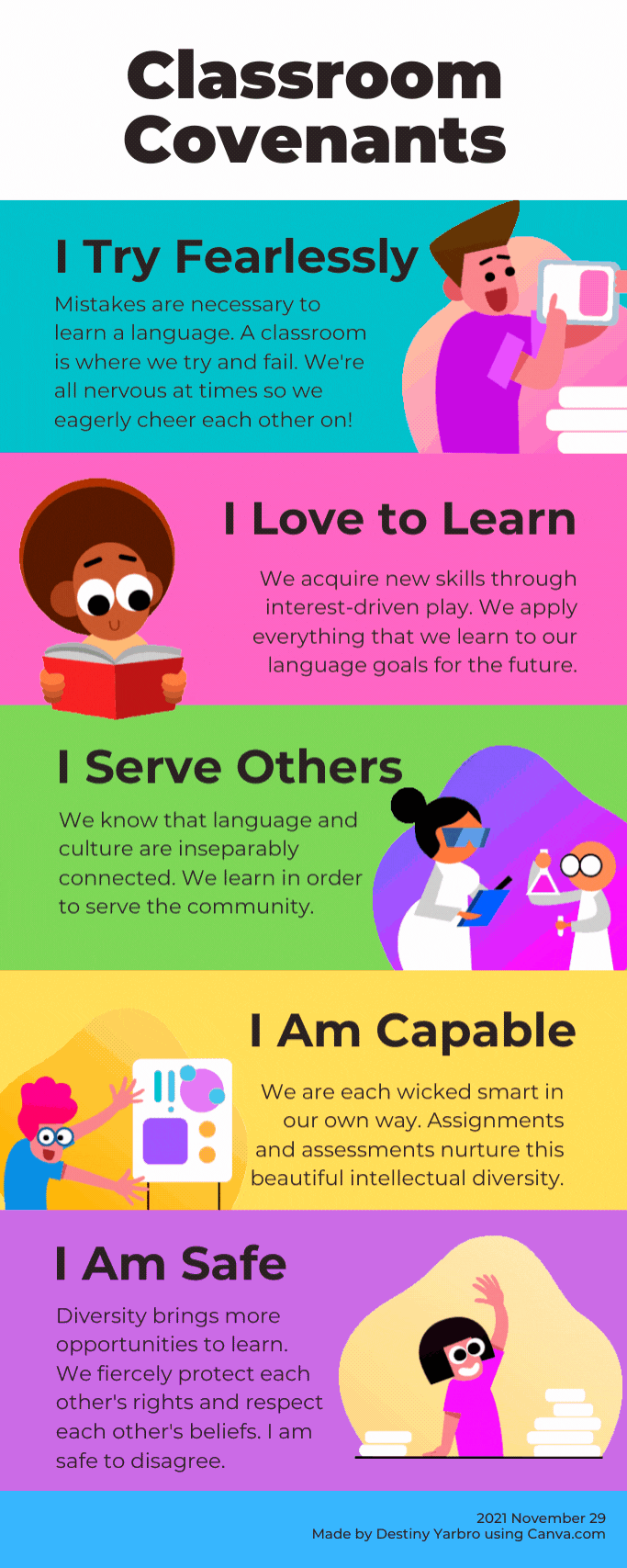- Destiny Yarbro
My Classroom Covenants [Infographic]

My goal for my language classes is for students to communicate and connect in their new language as soon as possible. Holding to this priority shapes my course structure, my daily lesson plans, and how I approach our classroom rules.
On the first day of class, rather than immediately jumping into the syllabus and rules, I instead have students immediately start using their new language in the form of an activity and teach a language concept that makes immediate sense. (Start with early successes so they are eager to learn more.) This clearly shows my students that applicable learning happens at the start of class while technicalities (like the syllabus and reminders) are held for the end.
As I teach college-level or community courses, I prefer commitments / covenants rather than traditional do / do not rules. Rather than only students submitting or conforming, covenants imply a promise by both students and teachers to create a positive classroom environment. When reviewing these covenants at the end of the first day of class, I also share personal experiences so my students better understand why these are much more than simple rules. Consequences are covered in the syllabus only.
The five covenants of my classroom are:
I commit to try and try. Mistakes are necessary to learn a language. This classroom is where we feel comfortable to try and fail. We have all been nervous at times so you can be rest assured that we will all eagerly cheer each other on!
Personal Experience: BYU professor gave students unlimited tries to take examinations for chemistry. If you failed the first examination, you could study and then take a new second examination. If you still failed, you could study and take a different third examination. His students loved him because if they were willing to try, he gave them ample opportunities. (See Educ 5210 Week 1 Portfolio)
I commit to love to learn. When we acquire new skills, we will enjoy learning them through interest-driven play. Do you love all things dinosaurs? Then you will become adept at Visual Gestural Communication (VGC) through describing dinosaurs with classifiers. We know that “the brain makes the strongest connections through concrete experiences” and without concrete experiences, symbolic and abstract concepts have little or no meaning (SPOTS, 2008). Thus, we apply everything that we learn to our passions and our language goals for the future.
Personal Experience: Mr. Sprague, our middle school band teacher, knew that the majority of students in our tiny rural town would not become professional musicians. Thus, rather than teach us music in the traditional way (technique and theory), his goal was to get us playing our instruments as quickly as possible and thoroughly love learning music. As an unanticipated result, many of these students went on to get scholarships and become professional musicians across the country. (See Educ 5210 Week 1 Portfolio)
I commit to serve others. We know that language and culture are inseparably connected. When we learn a language with the intent to serve others, we spark an emotional connection with what we learn thus increasing our retention. Learning with purpose elicits “rewarding stimuli” which focuses our efforts thus enabling us to learn more quickly (Krach, Paulus, Bodden & Kircher, 2010).
Personal Experience: I learned Hungarian quickly at the Missionary Training Center in Utah. Why? We were learning to “go forth and serve” the people of Hungary for two years so our language studies were focused on communication and connection. (See Educ 5210 Week 2 Portfolio)
I am capable. We are each wicked smart in our own way. If we expand the definition of smart to include skills beyond testing well, writing well, and calculating well, we realize that there truly are a variety of intelligence forms (Armstrong, 2018). Our classroom welcomes assignments and assessments that nurture this beautiful intellectual diversity.
Personal Experience: Formal, standardized tests terrify me. It does not matter how prepared I am, how long I studied, my anxiety hijacks my best efforts and I perform poorly. Project-based assessments are much more disability-friendly. (See Educ 5220 Week 7 Written)
I am safe. I am safe to be myself. I am safe to voice my opinion. I am safe to try and fail because my peers support me. We know that diversity brings more opportunities to learn thus we fiercely protect each other's rights and respect each other's beliefs.
Personal Experience: I was bullied in school because of my religious beliefs. A few of my teachers recognized this and opened their classroom for me during lunch so I could eat there in peace. If you are fasting for Ramadan or wearing rainbows for Pride Month, you will be physically and emotionally safe here. (See Educ 5210 Week 6 Portfolio)
Citations:
Armstrong, T. (2018). Multiple intelligences in the classroom (4th ed.). ASCD.
Krach, S., Paulus, F. M., Bodden, M., & Kircher, T. (2010). The rewarding nature of social interactions. Frontiers in behavioral neuroscience, 4, 22. https://doi.org/10.3389/fnbeh.2010.00022
Sun Protection Outreach by Students Training Manual (2008). The adolescent brain-Learning strategies & teaching tips. http://spots.wustl.edu/SPOTS%20manual%20Final/SPOTS%20Manual%204%20Learning%20Strategies.pdf









![My Classroom Covenants [Infographic]](https://static.wixstatic.com/media/297a08_5290e3cefb7549d5a00d4d622cea6b5c~mv2.jpg/v1/fill/w_38,h_21,fp_0.50_0.50,q_90,enc_auto/297a08_5290e3cefb7549d5a00d4d622cea6b5c~mv2.jpg)

![Ideal Seating Arrangements for the Sign Language Classroom [Infographic]](https://static.wixstatic.com/media/297a08_b14ca35c33294dd4957119a494fc80f7~mv2.jpg/v1/fill/w_38,h_21,fp_0.50_0.50,q_90,enc_auto/297a08_b14ca35c33294dd4957119a494fc80f7~mv2.jpg)

![Applying Learning/Interest/Activity Centers in the American Sign Language Classroom? [Infographic]](https://static.wixstatic.com/media/297a08_978159ba05814ff49a46439edd5096b9~mv2.gif)

![Learning Theory Highlights in University of the People's EDUC 5210 Course [Infographic]](https://static.wixstatic.com/media/297a08_f5cf0b68d8da416185272026e9be3ce9~mv2.jpg/v1/fill/w_38,h_21,fp_0.50_0.50,q_90,enc_auto/297a08_f5cf0b68d8da416185272026e9be3ce9~mv2.jpg)


